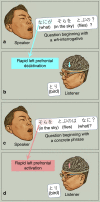Your verbal questions beginning with 'what' will rapidly deactivate the left prefrontal cortex of listeners
- PMID: 33664359
- PMCID: PMC7933162
- DOI: 10.1038/s41598-021-84610-1
Your verbal questions beginning with 'what' will rapidly deactivate the left prefrontal cortex of listeners
Abstract
The left prefrontal cortex is essential for verbal communication. It remains uncertain at what timing, to what extent, and what type of phrase initiates left-hemispheric dominant prefrontal activation during comprehension of spoken sentences. We clarified this issue by measuring event-related high-gamma activity during a task to respond to three-phrase questions configured in different orders. Questions beginning with a wh-interrogative deactivated the left posterior prefrontal cortex right after the 1st phrase offset and the anterior prefrontal cortex after the 2nd phrase offset. Left prefrontal high-gamma activity augmented subsequently and maximized around the 3rd phrase offset. Conversely, questions starting with a concrete phrase deactivated the right orbitofrontal region and then activated the left posterior prefrontal cortex after the 1st phrase offset. Regardless of sentence types, high-gamma activity emerged earlier, by one phrase, in the left posterior prefrontal than anterior prefrontal region. Sentences beginning with a wh-interrogative may initially deactivate the left prefrontal cortex to prioritize the bottom-up processing of upcoming auditory information. A concrete phrase may obliterate the inhibitory function of the right orbitofrontal region and facilitate top-down lexical prediction by the left prefrontal cortex. The left anterior prefrontal regions may be recruited for semantic integration of multiple concrete phrases.
Conflict of interest statement
The authors declare no competing interests.
Figures





Similar articles
-
Perturbation of left posterior prefrontal cortex modulates top-down processing in sentence comprehension.Neuroimage. 2018 Nov 1;181:598-604. doi: 10.1016/j.neuroimage.2018.07.059. Epub 2018 Jul 25. Neuroimage. 2018. PMID: 30055371
-
The role of the IFG and pSTS in syntactic prediction: Evidence from a parametric study of hierarchical structure in fMRI.Cortex. 2017 Mar;88:106-123. doi: 10.1016/j.cortex.2016.12.010. Epub 2016 Dec 18. Cortex. 2017. PMID: 28088041
-
The role of the left prefrontal cortex in sentence-level semantic integration.Neuroimage. 2013 Aug 1;76:325-31. doi: 10.1016/j.neuroimage.2013.02.060. Epub 2013 Mar 16. Neuroimage. 2013. PMID: 23507386
-
The neural basis of combinatory syntax and semantics.Science. 2019 Oct 4;366(6461):62-66. doi: 10.1126/science.aax0050. Science. 2019. PMID: 31604303 Review.
-
Sentence processing is uniquely human.Neurosci Res. 2003 Jul;46(3):273-9. doi: 10.1016/s0168-0102(03)00122-6. Neurosci Res. 2003. PMID: 12804788 Review.
Cited by
-
Association of ultraprocessed foods consumption and cognitive function among children aged 4-7 years: a cross-sectional data analysis.Front Nutr. 2023 Oct 10;10:1272126. doi: 10.3389/fnut.2023.1272126. eCollection 2023. Front Nutr. 2023. PMID: 37881777 Free PMC article.
-
Vowel Length Expands Perceptual and Emotional Evaluations in Written Japanese Sound-Symbolic Words.Behav Sci (Basel). 2021 Jun 21;11(6):90. doi: 10.3390/bs11060090. Behav Sci (Basel). 2021. PMID: 34205574 Free PMC article.
-
Developmental organization of neural dynamics supporting auditory perception.Neuroimage. 2022 Sep;258:119342. doi: 10.1016/j.neuroimage.2022.119342. Epub 2022 May 30. Neuroimage. 2022. PMID: 35654375 Free PMC article.
-
Visualization of functional and effective connectivity underlying auditory descriptive naming.Clin Neurophysiol. 2025 Jul;175:2010729. doi: 10.1016/j.clinph.2025.04.008. Epub 2025 Apr 21. Clin Neurophysiol. 2025. PMID: 40349545
References
Publication types
MeSH terms
Grants and funding
LinkOut - more resources
Full Text Sources
Other Literature Sources

